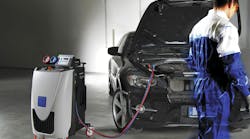The U.S. House of Representatives is set to consider the Fiscal Year 2020 Transportation Appropriations legislation on the House floor soon. The bill provides $86.6 billion for investments in infrastructure and other U.S. Department of Transportation administrative and project expenditures. Important for independent automotive repairers are House Appropriations Committee initiatives that were also included the legislation. These are member priorities that are likely to make it through floor debate and, quite possibly, the conference with the U.S. Senate.
House and Senate Appropriations Committees are trying to get their bills approved prior to the end of the fiscal year, Sept. 30, 2019. The Transportation bill will be bundled with four other appropriations packages for the next fiscal year. This “minibus” is an effort to avoid the gridlock in the appropriations process in recent congressional sessions.
Some of the key initiatives included, relative to automotive repairers, are the creation of a new Center for Excellence at the U.S. Department of Transportation (DOT) that focuses on Highly Automated Systems Safety, a provision directing the National Highway Traffic Safety Administration to provide more regulatory oversight of the development of autonomous vehicles and instructions for NHTSA to re-focus its efforts on new structural materials for vehicle manufacturing.
Highly Automated Systems Safety Center of Excellence (COE) — Advanced technologies are rapidly transforming the national transportation system, and are already critical components in airplanes, trains, and motor vehicles. In recent years, multiple fatal accidents have underscored the importance of validating the safety of new technologies. As automated technologies become increasingly widespread, the Committee believes the safety of the traveling public jointly depends on technology developers, owners and operators, and appropriate Federal regulations and effective oversight. To ensure automated technologies are safe and work as intended, the Department must have a workforce that can review and analyze complex transportation-based systems. The Committee directs the Secretary to stand up the Highly Automated Systems Safety COE. The Highly Automated Systems Safety COE would serve as a dedicated workforce at the Department with the necessary skills and expertise in automation and human behavior, including but not limited to, computer science, machine learning, sensors, and other technologies to audit, inspect, and certify the safety of highly automated systems across all modes of transportation.
Autonomous vehicles — Autonomous vehicles (AVs) have the potential to fundamentally transform transportation networks by reducing the number of lives lost on our roads and by improving mobility options. Research into the safety and operations of these new technologies is a key part of NHTSA’s mission. To that end, the Committee provides not less than $18,500,000 for NHTSA to continue research on AVs, automated driving systems (ADS), advanced driver assistance systems (ADAS), and vehicle electronics and cybersecurity. The Committee anticipates that NHTSA will include analysis of both vehicles without drivers and without passengers in its analysis. The Committee is concerned that the development of AVs is not receiving sufficient oversight from NHTSA. The Committee supports performance based minimum standards for AVs and directs NHTSA to collaborate with the Office of the Secretary to ensure that AVs are safe for occupants, other drivers, pedestrians and cyclists. The Committee directs NHTSA to report to the House and Senate Committees on Appropriations on their plans to collaborate within 180 days of enactment of this Act.
Crashworthiness research —The Committee recognizes the importance that lightweight plastics and polymer composites play to improve automotive safety, meet consumer demand for innovative vehicles, increase fuel efficiency, and support new U.S. highly skilled manufacturing jobs. NHTSA is encouraged to focus on updating the countermeasures in its frontal, side, rollover, front seatbacks and lower interior impacts for children and small adults as well as pedestrian crashworthiness projects, with an emphasis on vehicle light weighting in both traditional and autonomous vehicle structural designs.
To view more of Congress’ efforts in the automotive space, please go to ASA’s legislative website, www.TakingtheHill.com.

